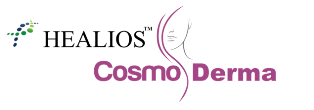What is molluscum contagiosum?
Molluscum contagiosum is a common viral skin infection of childhood that causes localised clusters of epidermal papules called mollusca.
Who gets molluscum contagiosum?
Molluscum contagiosum mainly affects infants and young children under the age of 10 years. It is more prevalent in warm climates than cool ones, and in overcrowded environments. Adolescents and adults are less often infected.
Mollusca tend to be more numerous and last longer in children who also have atopic eczema, due to deficiencies in the skin barrier. It can be very extensive and troublesome in patients with human immunodeficiency virus (HIV) infection or that have other reasons for poor immune function.
What causes molluscum contagiosum?
Molluscum contagiosum is caused by a poxvirus, the molluscum contagiosum virus. There are at least 4 viral subtypes.
There are several ways it can spread.
- Direct skin-to-skin contact
- Indirect contact via shared towels or other items
- Auto-inoculation into another site by scratching or shaving
- Sexual transmission in adults
Transmission of mollusca appears to be more likely in wet conditions, such as when children bathe or swim together. The incubation period is usually about 2 weeks but can be as long as 6 months.
What are the clinical features of molluscum contagiosum?
Molluscum contagiosum presents as clusters of small round papules. The papules range in size from 1 to 6 mm, and may be white, pink or brown. They often have a waxy, shiny look with a small central pit (this appearance is sometimes described as umbilicated). Each papule contains white cheesy material.
There may be few or hundreds of papules on one individual. They mostly arise in warm moist places, such as the armpit, behind the knees, groin or genital areas. They can arise on the lips or rarely inside the mouth. They do not occur on palms or soles.
When mollusca are autoinoculated by scratching, the papules often form a row.
Mollusca frequently induce dermatitis around them, which becomes pink, dry and itchy. As the papules resolve, they may become inflamed, crusted or scabby for a week or two.
Complications of molluscum contagiosum
Complications of Molluscum contagiosum can include:
- Secondary bacterial infection from scratching (impetigo)
- Conjunctivitis when eyelid is infected
- Disseminated secondary eczema; this represents an immunological reaction or ‘id’ to the virus
- Numerous and widespread mollusca that are larger than usual in immune deficiency, often on the face, eg giant mollusca in uncontrolled HIV infection or patients on immune suppressing drugs
- Scarring due to surgical treatment
How is molluscum contagiosum diagnosed?
Molluscum is usually recognised by its characteristic clinical appearance or on dermatoscopy. White molluscum bodies can often be expressed from the centre of the papules.
Sometimes, the diagnosis is made on skin biopsy. Histopathology shows characteristic intracytoplasmic inclusion bodies.
What is the treatment for molluscum contagiosum?
There is no single perfect treatment of molluscum contagiosum since we are currently unable to kill the virus. In many cases no specific treatment is necessary.
Physical treatments include:
- Picking out the soft white core (note, this could lead to autoinoculation)
- Cryotherapy (can leave white marks)
- Gentle curettage or electrodessication (can scar)
- Laser ablation (can scar)
Medical treatments include:
- Antiseptics such as hydrogen peroxide cream or povidone iodine solution
- Podophyllotoxin cream
- Wart paints containing salicylic acid
- Cantharidine solution
Imiquimod cream and sinecatechins are sometimes used but are unproven.
Secondary dermatitis may be treated symptomatically with a mild topical topical corticosteroid such as hydrocortisone cream. It is unlikely to fully resolve until the molluscum infection has cleared up.
How can molluscum contagiosum be prevented?
Molluscum contagiosum is infectious while active. However, affected children and adults should continue to attend day care, school and work.
To reduce spread:
- Keep hands clean
- Avoid scratching or shaving
- Cover all visible lesions with clothing or watertight bandages
- Dispose of used bandages
- Do not share towels, clothing or other personal effects
- Adults should practice safe sex or abstinence
What is the outlook for molluscum contagiosum?
In immune competent hosts, molluscum contagiosum is a relatively harmless. The papules may persist for up to 2 years or longer. In children, about half of cases have cleared by 12 months, and two-thirds by 18 months, with or without treatment. Contact with another infected individual later on can lead to a new crop of mollusca.
Infection can be very persistent in the presence of significant immune deficiency.

 7975288129 / 7483528607
7975288129 / 7483528607
